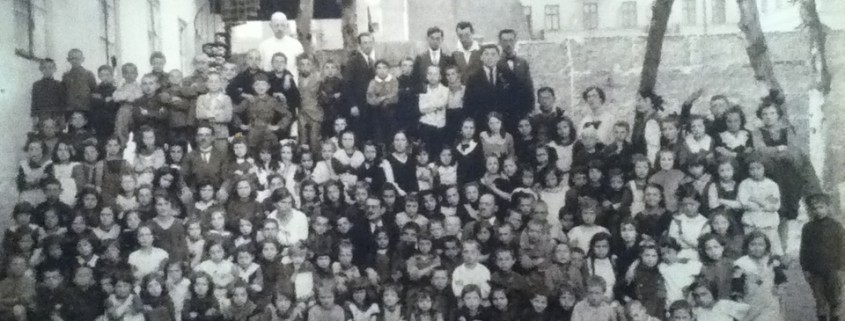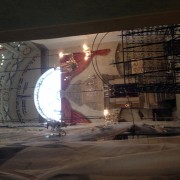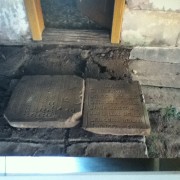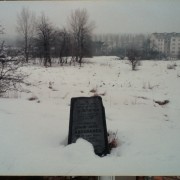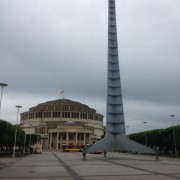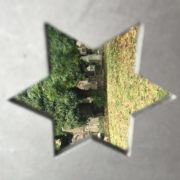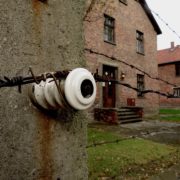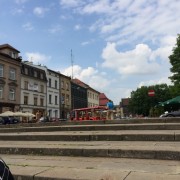Shadows of a Hidden Past
By Kaylee De Zalia
At first glance, the Galicia Jewish Museum seems small for a museum. As our group filed through the door, the first thing I saw was the café. I could not see any of the exhibits, just the café and the gift shop. I was anticipating our visit, and had a few preconceived notions about what it would be like. Some of my guesses were accurate, however it was so much more than I had assumed it would be. This is a museum that not only presented the grievous experiences the Jews endured, but it also gave a narrative of daily Jewish life before the Holocaust, and the memorial efforts that have occurred afterwards. The Galicia Jewish Museum was founded in 2004 by Chris Schwarz and Jonathan Webber, as a manner of
preserving the European Jews’ past, in the hopes that this will encourage healing and growth in the future. By memorializing their history and explaining how, and why, things occurred the way that they did, future generations will be able to develop a better understanding of the Jewish culture and history.
The setup of the museum was quite powerful and emotionally compelling. Inside this old brick building, the pieces are pictures with captions. The pictures could be maps, enlarged prints of preexisting photos, and photos from during and after WWII-many of which were taken by Charles Schwarz himself (http://www.en.galiciajewishmuseum.org/traces-of-memory-permanent-exhibition.html). He followed the remnants of the Jewish culture and people throughout Europe, so that their legacy would live on, even though their presence is greatly diminished today. By having the main focus of the exhibit placed on giant photographs with only a small written piece, the exhibit – Traces of Memory, is eye-catching and effective. One can now place specific images and stories into the broader context; it becomes much more individual, relatable and humanized.
Before we entered Traces of Memory, we quickly walked through another exhibit. This showed the heavy involvement of the “Joint”, an American Jewish organization, in the lives of many Jewish people starting before World War I. Amongst other things, the “Joint” (short for the Joint Distribution Committee) supported Jews living in Palestine during World War I, and after WWI, cared for people by providing humanitarian aid at a time when Europe was being rebuilt (http://www.en.galiciajewishmuseum.org/traces-of-memory-permanent-exhibition.html). I had never heard of this group, and so it was interesting hearing about this organization that had a massive impact on the global Jewish population-especially in times of rising Anti-Semitism. I could see specific examples of their work. There were pictures of various aspects of community life: elders gathered together, medical care programs, and schools. I was surprised by how large some of the groups were (photographer unknown). It was a unique surprise learning experience to see the work of an influential U.S.-based organization that donated a great deal of time and money to promote the wellbeing of Jews in Eastern Europe, Palestine, and other parts of the world.
Traces of Memory’s arrangement was carefully considered. How best to convey the story of Galician Jews? What will create the largest impact? I found that the later sections on the Holocaust and the destruction of the Jewish community resonated with me even more, because we began with Jewish life before WWII. I had some knowledge of Jewish life and the rich culture/community in Central and Eastern Europe. The tour provided me with a much more detailed history, as well as specific images-instead of simply having to rely on my imagination. The museum’s timeline extended back, long before the Holocaust. Our guide was quite informative; I had never realized that the first Jews began settling in Poland almost a thousand years ago. Finally, I received an explanation as to why Poland had the largest Jewish population in the world until the 1920’s. A Polish king of the Middle Ages expressly welcomed the Jews, and saw how they would benefit Poland. For the Jews facing persecution in other parts of Europe, Poland became a safe haven. Finally, here was a safe place-the end of wandering; this was home-or so they thought. No one could have ever imagined that someday, this land that
Seeing photos of the destruction wreaked on the Jews by the Nazis and others was made more poignant by seeing and hearing about their history. Comparing the past to the “present” (1930’s on) was such a sharp contrast. They were a sizeable minority with a complex history. Even though they had faced discrimination, and hatred throughout their history, they continued to hold on to their faith and traditions, and to grow. After the Holocaust, the Europeans Jews were almost wiped out. Of those who survived, many left their homes (if they even still had them) and immigrated to Israel, the U.S.A., and other countries. The desecration of graves was one of the things that horrified me the most. Imagining that random people would destroy or steal tombstones is absolutely horrible. These miniature memorials are gone. How are people supposed to know that they are standing amongst the dead? How are families to come and pay their respects? Someday they may forget exactly where the grave is, now they may not be able to find where their elders were laid to rest. A tombstone may also be the last remaining physical tie a family has to their deceased loved one. Taking the tombstone severs this connection, and dishonors the family of the deceased and his or her memory. It is difficult for me to fathom gravestones be stolen and then used to build roads, steps, or even being broken down and later reused as building materials (photo by Chris Schwarz from Traces of Memory) .
The Galicia Jewish Museum in Krakow, Poland truly opened my eyes to various aspects of the destruction of Jewish life. One image in particular struck me. A lone gravestone in the midst of a snowy field-that had once been a Jewish cemetery, which now appears to be merely a field (photo by Chris Schwarz from Traces of Memory). All of the other markers had been stolen or vandalized; only one has survived. This image epitomizes the museum. The image itself is compelling; out of an entire cemetery, only a single stone is still standing in this lonely and desolate landscape. It also symbolizes the past in which there was a large, living, breathing community that now is struggling to survive. How even its memory has been partially stamped out, yet the scars of the past remain to remind us of what once was. Walking through Kazimierz afterwards, I attempted to imagine what it once must have been like. The elderly reminiscing and sharing stories, children playing- with their mothers keeping a close eye on them, and the synagogues full of faithful worshippers. Now, I looked around and only saw the ghosts of this past. Homes that look worn and empty, and buildings covered in markings as mezuzahs were stripped from the door frame. Synagogues that lie unused, because the community is now so miniscule, are in desperate need of care (photo courtesy of Michael Kosowski). Sure there are people, but how many are tourists like myself? I cannot help but wonder, will a comparable Jewish community ever exist here again? Or it is doomed to only live on in the history books?

